Isotherm and Kinetic Studies on Escherichia colifor Cadmium-Contaminated Wastewater Treatment
| Received 11 Sep, 2025 |
Accepted 09 Nov, 2025 |
Published 10 Nov, 2025 |
Background and Objective: Cadmium (Cd) contamination poses a major environmental and public health concern due to its toxicity, persistence, and bioaccumulation. Conventional remediation methods are often costly and inefficient, generating secondary pollution. This study aimed to evaluate the biosorption potential ofEscherichia coli isolated from a plastic recycling plant for the removal of Cd (II) ions from aqueous solutions, using isotherm and kinetic modeling to characterize adsorption behavior. Materials and Methods: Soil samples from a plastic recycling site were processed to isolate E. coli, identified through Gram staining and biochemical tests. Biomass was prepared and used in batch biosorption experiments under varying pH, contact time, initial Cd concentration, and biomass doses. Residual Cd levels were measured using atomic absorption spectrophotometry (AAS). Adsorption data were analyzed using Langmuir and Freundlich isotherms and kinetic models, including pseudo-first and pseudo-second order equations. Results: Maximum Cd (II) uptake occurred at pH 7, with equilibrium reached within 24-28 hrs. Adsorption capacity increased with initial Cd concentration until saturation. The pseudo-first order kinetic model best fitted the data, while the Langmuir isotherm showed the highest correlation, indicating monolayer adsorption on homogeneous sites. The maximum adsorption capacity was 50.013 mg/g. Conclusion: The findings confirm that E. coli biomass serves as an effective, low-cost biosorbent for Cd (II) removal under laboratory conditions. Its performance aligns with established biosorption models, supporting its potential application in wastewater treatment. Further studies on regeneration efficiency, column operations, and molecular adsorption mechanisms are recommended for practical implementation.
| Copyright © 2025 Anih et al. This is an open-access article distributed under the Creative Commons Attribution License, which permits unrestricted use, distribution, and reproduction in any medium, provided the original work is properly cited. |
INTRODUCTION
Industrialization and expanding plastic-related activities have increased heavy-metal inputs to the environment; Cd is particularly problematic due to toxicity, persistence, and bioaccumulation1. Recent reviews document the environmental impacts of plastic recycling and related waste streams on metal contamination2. Anthropogenic activities and improper waste handling further exacerbate environmental degradation and the need for affordable remediation technologies3.
Conventional physicochemical treatments (e.g., chemical precipitation, ion exchange) are effective but often costly and can generate secondary wastes; adsorption and biosorption are attractive low-cost alternatives4. Biosorption passive binding of metal ions onto the surfaces of biological materials, has been widely studied for Cd, Pb, Cu, and other heavy metals5. Proper application of isotherm and kinetic models (Langmuir, Freundlich, pseudo-first and pseudo-second order) is essential to interpret sorption behaviour and to guide scale-up6.
Biomasses used for biosorption include microbial cells and agricultural/industrial wastes (nutshells, husks, pods), and many studies have demonstrated high sorption capacities for such materials7. Comprehensive reviews of low-cost adsorbents show consistent patterns in capacity, kinetics, and influencing factors that can guide Experimental design8. Local agricultural residues and microbial isolates are especially attractive in resource-limited settings because they are inexpensive and locally available9-12.
Several studies have characterized adsorption kinetics and isotherms for groundnut husk, Senna tora (modified and unmodified), and Dennettia tripetala, providing benchmarks for both isotherm parameters and kinetic regimes13-15. Works on alginate composites, LDH intercalates, and polymeric hydrogels illustrate engineered biosorbents with high capacities and are helpful comparators for microbial systems16. Guidance on correct isotherm selection, linearization pitfalls, and interpretation is essential to prevent misapplication of models17-21.
This study isolates E. coli from a plastic recycling plant and evaluates Cd (II) biosorption across pH, contact time and concentration ranges.
MATERIALS AND METHODS
Study area and sample collection: The research was conducted at the Microbiology Laboratory of the Federal University, Wukari, Taraba State, Nigeria, over six months (January to June, 2024). Wukari, a historically significant city formerly part of the defunct Gongola State, is strategically located between Taraba and Benue States. Geographically, it is bounded to the south by Benue State, to the north by Gassol Local Government Area (LGA), to the East by Donga LGA and Takum, and to the West by Ibi LGA.
Climatic conditions in Wukari are characterized by relative humidity ranging from 14 to 77%. The city covers a land area of 4,308 km2 and recorded a population of approximately 241,546 during the 2006 national census. Beyond its demographic and geographic attributes, Wukari is recognized as a traditional state with a rich cultural heritage, encompassing diverse norms, values, and practices that contribute to its socio-cultural identity22.
Sample collection: A sampling site was precisely mapped out for soil sample collection, which was a plastic recycling site at Ambassador Roundabout, Wukari, Taraba State. Samples were stored at 4°C and processed within 24 hrs.
Materials: Hand gloves, cotton wool, Nutrient Agar (NA), MacConkey Agar (MA), Potato dextrose Agar (PDA), petri dish, masking tape, distilled water, wire loop, dropper, syringe and needle, measuring cylinder, test-tube, autoclave, weighing balance and pH meter, Spectrophotometer, Shakers, and Beakers.
Media preparation: The various media (PDA), Potato Destrose Agar, (MCA) MacConkey Agar, (NA) Nutrient Agar, were weighed according to the manufacturer’s instructions and sterilized at 121°C for 15 min at 15 PSI.
After sterilization, it was allowed to cool to a temperature bearable to the skin.
Isolation and identification of E. coli: Serial dilutions were plated on MacConkey and Nutrient agar, and distinct colonies were purified. Phenotypic identification used Gram staining and standard biochemical tests (indole, citrate, TSI, catalase, oxidase)23. Selected isolates were maintained for biosorption assays24.
Preparation of biosorbent and reagents: Biomass was produced by culturing the chosen E. coli isolate in nutrient broth overnight, harvesting by centrifugation, washing three times with deionized water and using either wet biomass or oven-dried biomass as indicated. Analytical-grade CdCl was used to prepare stock and working solutions25-27.
Batch biosorption experiments: Batch experiments were carried out with 100 mL working volume in 250 mL flasks. Parameters tested: Initial Cd concentration (5-50 mg/L), pH (3, 5, 7, 9), contact time (0-48 hrs), and biomass dose (0.1-1.0 g/100 mL). After contact, samples were centrifuged and supernatants analysed for residual Cd by AAS. Percent removal and qe (mg/g) were calculated using standard mass-balance equations28. Experimental design and batch vs fixed-bed considerations followed established guidance29.
Isotherm and kinetic modelling: Equilibrium data were fitted to Langmuir and Freundlich isotherms; kinetics were analysed with pseudo-first and pseudo-second order models. Linear and non-linear regression approaches were used; fits were assessed by R2 and error metrics following recommended practice17. Representative comparators and modelling strategies from the literature were used to ensure robust parameter estimation30.
Data analysis: All experiments were performed in triplicate and results were reported as Mean±SD. Curve fitting and statistics were performed using standard software31.
RESULTS
Identification and biochemical profile of the isolate: The selected isolate demonstrated morphological and biochemical traits consistent with Escherichia coli (Gram-negative rods; indole positive in the tested strain)23.
Table 1 summarizes the biochemical test results used to identify the Escherichia coli isolate. The table lists Gram staining, enzymatic activities, sugar fermentation profiles, and growth characteristics on MacConkey agar. These results confirm the morphological and biochemical traits consistent with E. coli.
Biochemical characteristics of bacterial isolates from the plastic recycling plant site. Data include Gram reaction, enzyme tests, sugar fermentation patterns, and colony morphology on MacConkey agar.
Effect of contact time: Adsorption occurred rapidly during the initial phase (0-8 hrs) and approached steady state by ~24-28 hrs. This time course is consistent with sorption profiles reported for microbial and plant-based biosorbents32.
Figure 1 presents the contact time profile for Cd (II) biosorption by Escherichia coli. The curve shows a rapid uptake within the first 8 hrs, followed by a slower approach to equilibrium at 24-28 hrs.
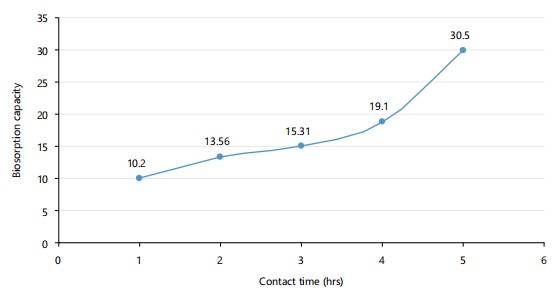
|
| Table 1: | Biochemical test for E. coli | |||
| Code | Gram Staining |
Catalyst Test |
Coagulase Test |
Simon citrate test |
Glucose test |
Sucrose test |
Galactose test |
Oxidase |
| MacConkey | Rod-Chain | + | - | + | - | - | - | + |
| Agar Plate1 White | Shape (Purple) | |||||||
| MacConkey | Cocci (Purple) | + | - | - | + | - | - | + |
| Agar Plate1 Pale Yellow | ||||||||
| MacConkey | Rod Shape | + | - | - | + | - | - | - |
| Agar Plate 2 Yellow | (Purple) | |||||||
| MacConkey | Rod Shape | + | - | - | + | + | + | + |
| Agar Plate 2 White | (Purple) | |||||||
| MacConkey | Cluster Rod | + | - | - | + | + | + | - |
| Agar Plate1 Yellow | Shape (Purple) | |||||||
| MacConkey | Rod Shape | + | + | - | - | - | - | - |
| Agar Plate1 White | (Purple) | |||||||
| MacConkey | Rod shape | + | - | - | - | - | - | + |
| Agar Plate 2 Yellow | (Purple) | |||||||
| Plate 2 Yellow | Rod shape (Purple) | + | - | - | - | - | - | - |
| Plate1 White | Rod shape (Purple) | + | + | + | + | + | + | - |
| Plate1 Yellow | Rod shape (Purple) | + | - | + | + | - | - | - |
| Plate 3 Yellow | Cocci (Purple) | - | - | - | + | + | + | - |
Effect of solution pH: Maximum uptake occurred at neutral pH (pH 7); adsorption decreased at low pH (proton competition) and at very high pH (possible precipitation/speciation effects). These pH dependencies align with widely reported observations for biosorbents33.
Figure 2 illustrates the pseudo-first-order kinetic model fit for Cd (II) biosorption. The linear plot of log(qe-qt) versus time demonstrates a strong correlation between experimental and model-predicted values. This supports the conclusion that pseudo-first-order kinetics best describe the system.
Effect of initial metal concentration and biomass dose: The qe increased with initial concentration until a plateau, indicating sorbent saturation was reached; increasing biomass dose increased total removal but lowered qe (mg/g) due to site distribution effects, as discussed in batch vs column comparisons34.

|
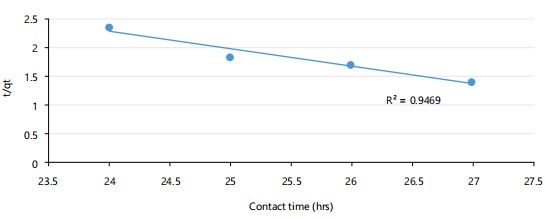
|
Figure 3 shows the pseudo-second order kinetic model plot for Cd (II) biosorption. The t/qt versus time relationship indicates a reasonable fit, though slightly less accurate than the pseudo-first order model. This comparison aids in identifying the dominant adsorption mechanism.
Kinetic modelling: Kinetic curves fitted both pseudo-first and pseudo-second order models reasonably; pseudo-first order produced a slightly better R² and qcalc agreement with qexp for these data (Table 2)35.
Table 2 presents the kinetic parameters for Cd (II) biosorption by Escherichia coli. It compares pseudo-first order and pseudo-second order model fits, showing calculated adsorption capacities, rate constants, and correlation coefficients. The data indicate a better fit for the pseudo-first order model.
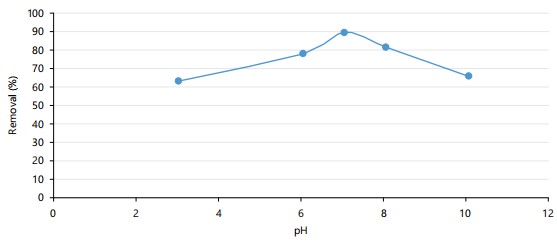
|
| Table 2: | Kinetic parameters for the biosorption of Cd ions by Escherichia coli isolated from a plastic recycling plant | |||
| Kinetic models | Cd (II) |
| qeexp (mg/g) | 48.83 |
| Pseudo-first order | |
| qecal, (mg/g) | 46.214 |
| K1, (min-1) | 0.031 |
| R2 | 0.961 |
| Pseudo-second order | |
| qecal, (mg/g) | 30.21 |
| K2 (g/mg/min) | 0.125 |
| h (mg/g/min) | 1.22 |
| R2 | 0.947 |
| Kinetic model parameters for Cd (II) biosorption by Escherichia coli, Values include experimental and calculated qe, rate constants (K1, K2), initial sorption rate (h), and R² for each model | |
| Table 3: | Equilibrium isotherm parameters for the bio sorption of Cd ions by Escherichia coli isolated from a plastic recycling plant | |||
| Isotherm model | Cd (II) |
| Langmuir model | |
| qL(mg/g) | 50.013 |
| KL(L/mg) | 0.21 |
| R2 | 0.924 |
| Freundlich model | |
| KF (L/g) | 1.202 |
| 1/n | 0.201 |
| R2 | 0.873 |
| Equilibrium isotherm parameters for Cd (II) biosorption by Escherichia coli. Langmuir constants (qL, KL) and Freundlich constants (KF, 1/n) are shown with corresponding R² values | |
Isotherm modelling: Equilibrium data fitted best to the Langmuir model (high R2), indicating monolayer adsorption on finite binding sites. Freundlich constants indicated heterogeneity consistent with biological sorbents (Table 3)36.
Figure 4 depicts the effect of solution pH on Cd (II) biosorption, maximum uptake occurs at pH 7, with reduced adsorption at both acidic and alkaline extremes. This trend reflects the influence of proton competition and metal precipitation on biosorption efficiency.
Figure 5 presents the effect of initial Cd (II) concentration on biosorption capacity, Adsorption capacity increases with concentration until reaching a plateau, indicating sorbent saturation. This behaviour is characteristic of monolayer adsorption systems.
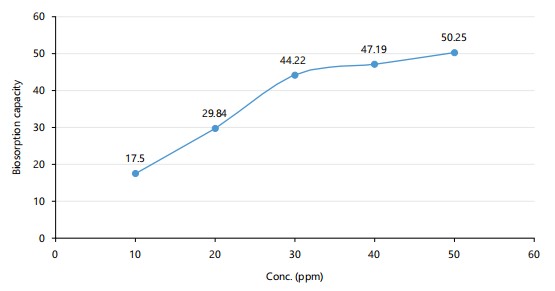
|
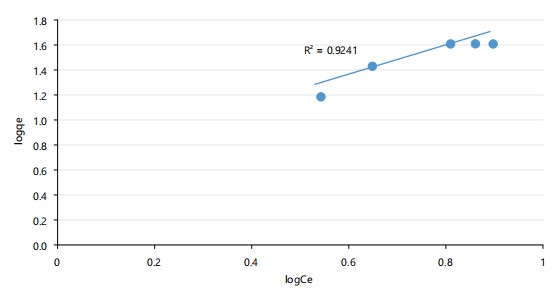
|
Figure 6 shows the Langmuir isotherm model plot for Cd (II) biosorption, The linear relationship supports the assumption of monolayer adsorption on homogeneous binding sites. The high correlation coefficient confirms the model’s suitability.
Figure 7 illustrates the Freundlich isotherm model plot for Cd (II) biosorption The plot indicates surface heterogeneity and multilayer adsorption potential. Although the fit is slightly lower than Langmuir’s, it provides complementary insight into sorption behaviour.
Table 3 summarises the Equilibrium isotherm parameters for Cd (II) biosorption, Langmuir constants indicate high monolayer adsorption capacity, while Freundlich constants suggest surface heterogeneity. The higher R2 value for Langmuir confirms its superior fit to the experimental data.

|
DISCUSSION
This study, evaluated the ability of Escherichia coli biomass, collected from a plastic recycling site, to remove Cd (II) from water. Experiments show a maximum adsorption capacity (qm) of 50.013 mg/g, an optimum pH of about 7, and an approach to equilibrium within roughly 24 to 28 hrs. The equilibrium data fit a Langmuir-type isotherm and the kinetic behavior is best described by a pseudo-first-order model.
Cd (II) uptake is highest near neutral pH and declines at low pH fits well with the mechanistic picture reported by Patel16 and others. Those authors show how pH controls metal speciation and the ionization state of surface functional groups, so proton competition at acidic pH naturally reduces available binding sites. Tran et al.29 also caution that apparent increases in removal at high pH can sometimes reflect metal precipitation rather than true sorption. Taken together, these studies support our interpretation that pH 7 most reliably represents true biosorptive binding rather than an artifact of solution chemistry.
The kinetic profile we observed a rapid initial uptake over the first few hours followed by a slower approach to equilibrium, is consistent with many reports on microbial and plant-based sorbents. Bullen et al.17 and Foo and Hameed30 describe how an early, fast phase is often controlled by surface adsorption and film diffusion, while later uptake reflects intraparticle diffusion or site reorganization. Our data show a slightly better fit to a pseudo-first-order model, which plausibly indicates that physical adsorption and diffusion processes dominate under our conditions rather than exclusive chemisorption. This interpretation aligns with the kinetic analyses reported by Bullen et al.17 and with broader reviews summarized by Foo and Hameed30.
The equilibrium behavior favoring a Langmuir-type isotherm suggests monolayer adsorption on a finite number of relatively uniform sites. Similar Langmuir type fits have been reported for a variety of biological sorbents: Dias et al.7 reported Langmuir behavior for nutshell-derived materials, and Zhang et al.15 observed comparable fits for alginate-based composites. The q we measured, around 50 mg/g, places our E. coli biomass in a competitive range when compared with many low-cost sorbents. For example, Tatah et al.10 report capacities for several agricultural residues in a similar range, and engineered biocomposites evaluated by Park et al.14 and Zhang et al.15 show comparable performance.
Practical trade-off commonly seen in batch sorption work: raising biomass dose increases total percent removal but can reduce adsorption per unit mass. Patel16 and Foo and Hameed30 explain this phenomenon as resulting from overlapping diffusion layers, reduced driving force per unit mass, and site aggregation at high sorbent loadings. These insights will guide how we scale the system: higher sorbent doses improve effluent quality but may be less efficient on a mass basis.
Sourcing biomass from a recycling site adds a sustainability dimension to our work. Fabre et al.18 and Boakye et al.19 advocate valorizing waste biomass for remediation, and our results show that such an approach can yield competent biosorbents. Recent reviews on bacterial biosorbents by Pham et al.34 and Rizvi et al.35 reinforce the idea that bacterial biomass can be scaled while reminding us to address regeneration, stability, and biosafety before field deployment.
There are methodological points to acknowledge. Tran et al.29 remind us not to overinterpret model fits when relying only on linearized plots or R2 values. We used both linear and nonlinear fitting approaches and reported error metrics, which strengthens confidence in our conclusions. Nevertheless, targeted follow up work would make our mechanistic claims more robust. I recommend thermodynamic studies, surface characterization by FTIR or XPS, and column-scale trials as suggested by Zhou et al.25 to validate batch findings under continuous flow and in complex matrices. Multi-metal and real wastewater experiments will also be essential because competitive sorption can alter both capacity and selectivity.
In summary, our findings are consistent with established biosorption principles: pH dependence, rapid initial uptake with diffusion-limited equilibration, Langmuir type equilibrium behavior, and competitive qm values. The novel contribution of this study is showing that E. coli biomass sourced from a recycling environment is a promising, low-cost biosorbent. Based on these results, column experiments, regeneration studies, and targeted surface analyses are being conducted to advance toward practical application.
CONCLUSION
This study confirms that Escherichia coli isolated from a plastic recycling plant demonstrates strong biosorption potential for Cd (II) ions under controlled laboratory conditions. Maximum removal efficiency was achieved at neutral pH, with equilibrium attained within 24-28 hrs. The biosorption behavior followed the Langmuir isotherm and pseudo-first-order kinetic models, indicating monolayer adsorption and a diffusion-driven mechanism. These results establish E. coli biomass as an effective and low-cost biosorbent for cadmium removal in wastewater treatment.
Further research should explore the regeneration and reuse potential of the biomass and conduct pilot-scale column experiments to evaluate performance under continuous flow conditions. Integrating this biosorbent into modular treatment systems may provide scalable and sustainable solutions for industrial effluents, particularly in resource-limited regions. Moreover, molecular-level investigations of metal-binding mechanisms would deepen understanding and support optimization for broader heavy metal remediation applications.
SIGNIFICANCE STATEMENT
Heavy metal contamination, particularly cadmium in water, remains a critical environmental and public health issue requiring affordable and sustainable remediation strategies. This study demonstrates that Escherichia coli biomass obtained from a plastic recycling site effectively removes Cd (II) (q ≈50.0 mg/g), achieving optimal uptake at approximately neutral pH (≈7) with consistent kinetic and equilibrium performance. These findings highlight that waste-derived microbial biomass can perform comparably to other low-cost sorbents and can be readily integrated into existing treatment workflows. The proposed approach aligns with circular economy principles and offers a viable pathway toward pilot-scale testing, multi-metal evaluations, and deployment in resource-constrained environments.
ACKNOWLEDGMENT
The authors gratefully acknowledge the Department of Biochemistry, Faclty of Biosciences, Federal University Wukari, Taraba State, Nigeria, for providing the laboratory facilities and technical support necessary for the successful completion of this research. Special thanks go to the staff of the Microbiology Laboratory for their assistance during the microbial analysis and batch adsorption experiments. We also extend our appreciation to the management of the plastic recycling facility in Wukari for granting access to sample collection.
REFERENCES
- Singh, N. and T.R. Walker, 2024. Plastic recycling: A panacea or environmental pollution problem. npj Mater. Sustainability, 2.
- Khajvand, M., A.K. Mostafazadeh, P. Drogui and R.D. Tyagi, 2022. Management of greywater: Environmental impact, treatment, resource recovery, water recycling, and decentralization. Water Sci. Technol., 86: 909-937.
- Bisht, A., N. Kamboj, V. Kamboj and A. Bisht, 2020. A review on the role of emerging anthropogenic activities in environmental degradation and emphasis on their mitigation. Arch. Agric. Environ. Sci., 5: 419-425.
- Hussain, A., S. Madan and R. Madan, 2021. Removal of Heavy Metals from Wastewater by Adsorption. In: Heavy Metals-Their Environmental Impacts and Mitigation, Nazal, M.K. and H. Zhao (Eds.), IntechOpen, London, United Kingdom, ISBN: 978-1-83968-122-6.
- Shamim, S., 2018. Biosorption of Heavy Metals. In: Biosorption, Derco, J. and B. Vrana, IntechOpen, London, United Kingdom, ISBN: 978-1-78923-473-2, pp: 21-49.
- Al-Ghouti, M.A. and D.A. Da'ana, 2020. Guidelines for the use and interpretation of adsorption isotherm models: A review. J. Hazard. Mater., 393..
- Dias, M., J. Pinto, B. Henriques, P. Figueira and E. Fabre et al., 2021. Nutshells as efficient biosorbents to remove cadmium, lead, and mercury from contaminated solutions. Int. J. Environ. Res. Public Health, 18.
- Chakraborty, R., A. Asthana, A.K. Singh, B. Jain and A.B.H. Susan, 2022. Adsorption of heavy metal ions by various low-cost adsorbents: A review. Int. J. Environ. Anal. Chem., 102: 342-379.
- Silas, T.V., E.C. Stephen, M.A. Abah, A.S. Michael, U.J. Isaac and R.Y. Emochone, 2023. Growth indices of seeds (maize and cowpea) grown in heavy metal contaminated soil treated with ginger extract. Toxicol. Adv., 5.
- Tatah, V.S., K.L.C. Ibrahim, C.S. Ezeonu and O. Otitoju, 2017. Biosorption kinetics of heavy metals from fertilizer industrial waste water using groundnut husk powder as an adsorbent. J. Appl. Biotechnol. Bioeng., 2: 221-228.
- Silas, T.V. and A.S. Osagie, 2023. Biosorption of Fe (II) and Pb (II) on unmodified Senna tora: Isotherm and kinetic modeling. Magna Sci. Adv. Res. Rev., 8: 92-103.
- Silas, T.V. and A.S. Osagie, 2023. Biosorption of Cu (II) and Pb (II) ions using acid modified Senna tora pods with a focus on isotherms and kinetics studies. GSC Adv. Res. Rev., 16: 252-259.
- Silas, T.V. and A.S. Osagie, 2023. Biosorption isotherm and kinetic studies for the removal of Pb (II) and Fe (II) ions from synthetic waste water using unmodified Dennettia tripetala. GSC Biol. Pharm. Sci., 24: 319-328.
- Park, S., J.W. Lee, J.E. Kim, G. Kang, H.J. Kim, Y.K. Choi and S.H. Lee, 2022. Adsorptive behavior of Cu2+ and benzene in single and binary solutions onto alginate composite hydrogel beads containing pitch pine-based biochar. Polymers, 14.
- Zhang, X., R. Shan, X. Li, L. Yan, Z. Ma, R. Jia and S. Sun, 2021. Effective removal of Cu(II), Pb(II) and Cd(II) by sodium alginate intercalated MgAl-layered double hydroxide: Adsorption properties and mechanistic studies. Water Sci. Technol., 83: 975-984.
- Patel, H., 2022. Comparison of batch and fixed bed column adsorption: A critical review. Int. J. Environ. Sci. Technol., 19: 10409-10426.
- Bullen, J.C., S. Saleesongsom, K. Gallagher and D.J. Weiss, 2021. A revised pseudo-second-order kinetic model for adsorption, sensitive to changes in adsorbate and adsorbent concentrations. Langmuir, 37: 3189-3201.
- Fabre, E., C. Vale, E. Pereira and C.M. Silva, 2021. Sustainable water treatment: Use of agricultural and industrial wastes to remove mercury by biosorption. Water Air Soil Pollut., 232.
- Boakye, P., G. Ohemeng-Boahen, L. Darkwah, Y.A. Sokama-Neuyam and E. Appiah-Effah et al., 2022. Waste biomass and biomaterials adsorbents for wastewater treatment. Green Energy Environ. Technol., 2022.
- Min, H.S. and S. Ray, 2024. Removal of mercury Ions from wastewater using different techniques. Int. J. Eng. Trends Technol., 72: 21-34.
- Neag, E., A.I. Török, C. Tanaselia, I. Aschilean and M. Senila, 2020. Kinetics and equilibrium studies for the removal of Mn and Fe from binary metal solution systems using a Romanian thermally activated natural zeolite. Water, 12.
- Sarwuan, A.F., E.Z. Angyu and E.C. Toochi, 2015. Variations in climate change indicators and implications on forest resources management in Taraba State, Nigeria. Agric. For. Fish., 4: 252-256.
- Li, M.N., Q. Han, N. Wang, T. Wang and X.M. You et al., 2024. 16S rRNA gene sequencing for bacterial identification and infectious disease diagnosis. Biochem. Biophys. Res. Commun., 739.
- Chhetri, S., M.T. Sherpa and L. Sharma, 2025. Characterization of plant growth promoting bacteria isolated from rhizosphere of tomato cultivated in Sikkim Himalaya and their potential use as biofertilizer. Sci. Rep., 15.
- Zhou, Y., W. Liu, D. Chen, B. Liu, P. Lu and Y. Zhang, 2025. Simultaneous remediation of As(V), Cd(II) and Pb(II) in aqueous solution and soil using Fe/Ca-modified biochar. Waste Manage. Res., 43: 1206-1218.
- Zhao, J., S. Wang, L. Zhang, C. Wang and B. Zhang, 2018. Kinetic, isotherm, and thermodynamic studies for Ag(I) adsorption using carboxymethyl functionalized poly(glycidyl methacrylate). Polymers, 10.
- Wang, J. and X. Guo, 2023. Adsorption kinetics and isotherm models of heavy metals by various adsorbents: An overview. Crit. Rev. Environ. Sci. Technol., 53: 1837-1865.
- Al-Homaidan, A.A., H.J. Al-Houri, A.A. Al-Hazzani, G. Elgaaly and N.M.S. Moubayed, 2013. Biosorption of copper ions from aqueous solutions by Spirulina platensis biomass. Arabian J. Chem., 7: 57-62.
- Tran, H.N., S.J. You, A. Hosseini-Bandegharaei and H.P. Chao, 2017. Mistakes and inconsistencies regarding adsorption of contaminants from aqueous solutions: A critical review. Water Res., 120: 88-116.
- Foo, K.Y. and B.H. Hameed, 2010. Insights into the modeling of adsorption isotherm systems. Chem. Eng. J., 156: 2-10.
- Nthwane, Y.B., B.G. Fouda-Mbanga, M. Thwala and K. Pillay, 2025. A comprehensive review of heavy metals (Pb2+, Cd2+, Ni2+) removal from wastewater using low-cost adsorbents and possible revalorisation of spent adsorbents in blood fingerprint application. Environ. Technol., 46: 414-430.
- Wang, Z., S. Song, H. Wang, W. Yang, J. Han and H. Chen, 2022. Feasibility of remediation of heavy-metal-contaminated marine dredged sediments by active capping with enteromorpha biochar. Int. J. Environ. Res. Public Health, 19.
- Mahlangu, D., K. Mphahlele, F. de Paola and N.H. Mthombeni, 2024. Microalgae-mediated biosorption for effective heavy metals removal from wastewater: A review. Water, 16.
- Pham, V.H.T., J. Kim, S. Chang and W. Chung, 2022. Bacterial biosorbents, an efficient heavy metals green clean-up strategy: Prospects, challenges, and opportunities. Microorganisms, 10.
- Rizvi, A., B. Ahmed, A. Zaidi and M.S. Khan, 2020. Biosorption of heavy metals by dry biomass of metal tolerant bacterial biosorbents: An efficient metal clean-up strategy. Environ. Monit. Assess., 192.
- Song, Z., Y. Liu, L. Liu, C. Yang and W. Tian et al., 2024. Reusable magnetically-modified Enteromorpha prolifera-based biochar hydrogels: Competitive removal mechanism for metal-organic dye composite contaminants. Carbon Res., 3.
How to Cite this paper?
APA-7 Style
Anih,
D.C., Tatah,
V.S., Tekeme,
E.M., Samuel,
P., Olaitan,
S.L., Yellowe,
G.I., Sunday,
T.A., Clifford,
E., Joseph,
N.T., Nwitte-Eze,
U., Linus,
E.N. (2025). Isotherm and Kinetic Studies on Escherichia colifor Cadmium-Contaminated Wastewater Treatment. Trends in Applied Sciences Research, 20(1), 76-87. https://doi.org/10.3923/tasr.2025.76.87
ACS Style
Anih,
D.C.; Tatah,
V.S.; Tekeme,
E.M.; Samuel,
P.; Olaitan,
S.L.; Yellowe,
G.I.; Sunday,
T.A.; Clifford,
E.; Joseph,
N.T.; Nwitte-Eze,
U.; Linus,
E.N. Isotherm and Kinetic Studies on Escherichia colifor Cadmium-Contaminated Wastewater Treatment. Trends Appl. Sci. Res 2025, 20, 76-87. https://doi.org/10.3923/tasr.2025.76.87
AMA Style
Anih
DC, Tatah
VS, Tekeme
EM, Samuel
P, Olaitan
SL, Yellowe
GI, Sunday
TA, Clifford
E, Joseph
NT, Nwitte-Eze
U, Linus
EN. Isotherm and Kinetic Studies on Escherichia colifor Cadmium-Contaminated Wastewater Treatment. Trends in Applied Sciences Research. 2025; 20(1): 76-87. https://doi.org/10.3923/tasr.2025.76.87
Chicago/Turabian Style
Anih, David, Chinonso, Verwiyeh Silas Tatah, Ebikonboere Mary Tekeme, Paul Samuel, Sulaiman Luqman Olaitan, Godswill Igenewari Yellowe, Taiwo Adebayo Sunday, Efagene Clifford, Nwanze Tobechukwu Joseph, Ugo Nwitte-Eze, and Emmanuel Ndirmbula Linus.
2025. "Isotherm and Kinetic Studies on Escherichia colifor Cadmium-Contaminated Wastewater Treatment" Trends in Applied Sciences Research 20, no. 1: 76-87. https://doi.org/10.3923/tasr.2025.76.87

This work is licensed under a Creative Commons Attribution 4.0 International License.



